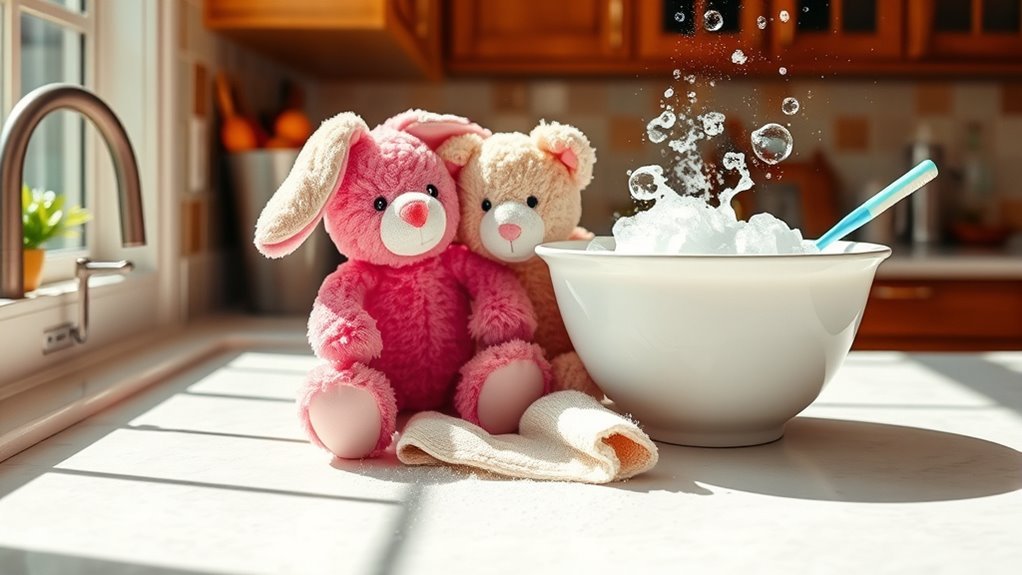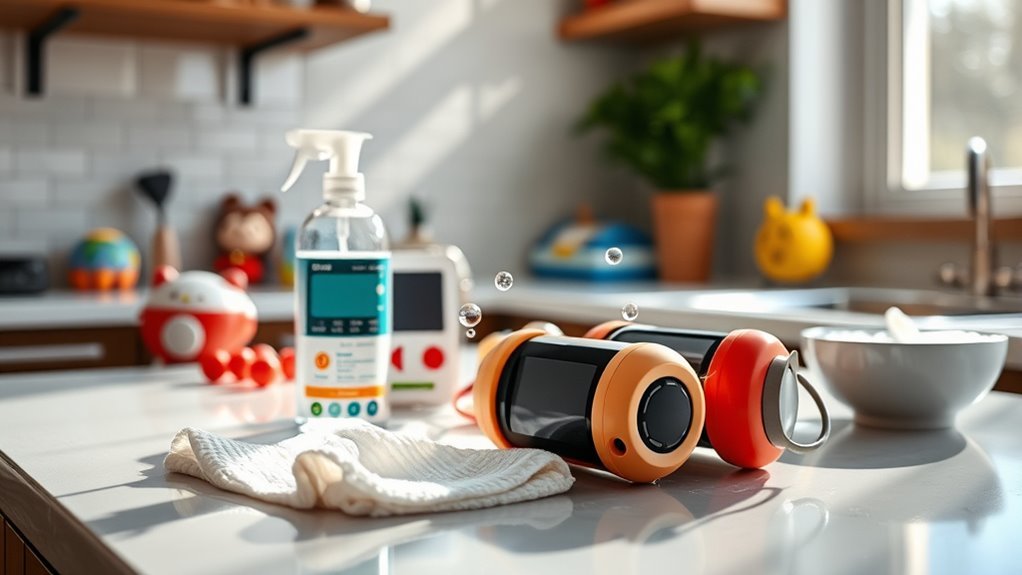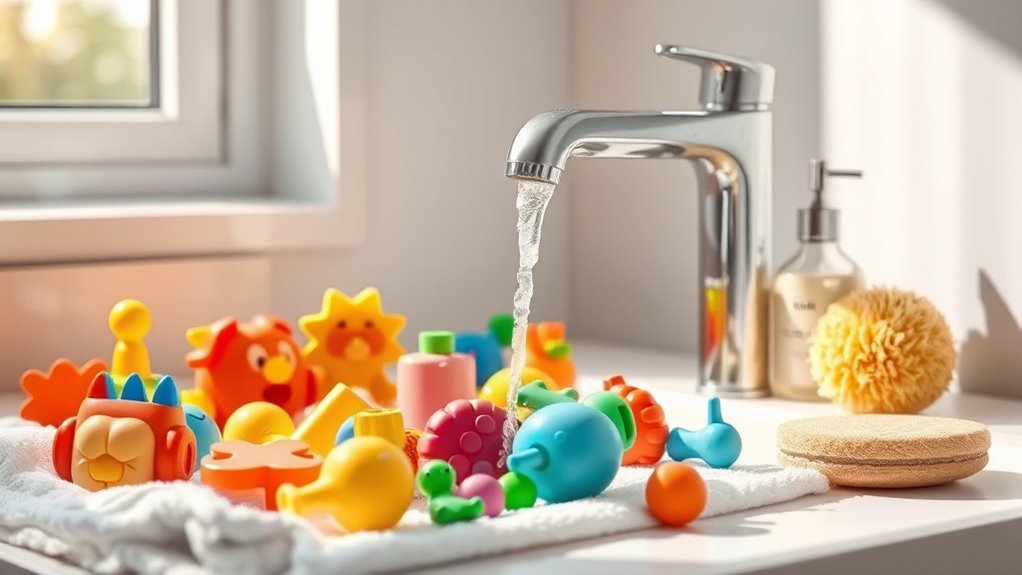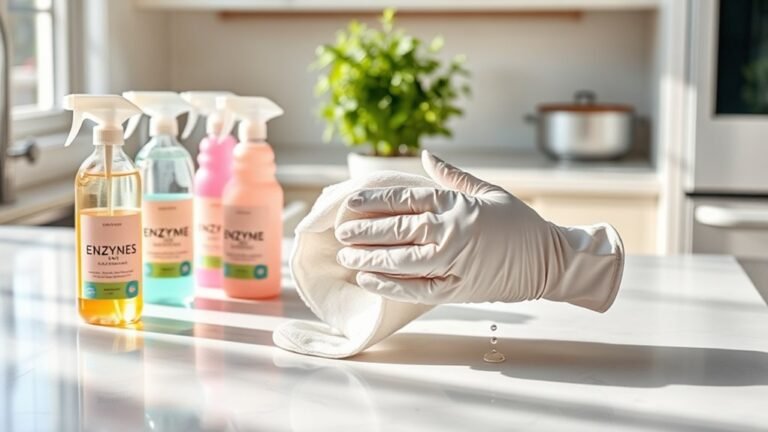How to Clean Your Toys Safely
To clean your toys safely, start by checking each toy’s label for washing instructions. Use gentle hand washing or a delicate machine cycle with mild detergent for soft toys, and air dry fully. For plastic toys, wipe with warm, soapy water using a soft cloth. Electronic toys need battery removal first, then a light disinfecting wipe with isopropyl alcohol. Avoid harsh chemicals to prevent damage. Keep your toys fresh and hygienic by following tailored cleaning methods designed for each type.
Cleaning Soft and Plush Toys

Although soft and plush toys can harbor dust and germs, cleaning them safely is straightforward if you follow the right steps. First, check the washing instructions on each toy’s label, as soft toy materials vary widely; some can be machine washed, while others require gentle hand washing. For machine washable toys, use a delicate cycle with mild detergent, placing the toy inside a pillowcase or laundry bag to protect it. If hand washing is required, soak the toy in warm water with mild soap, gently scrubbing stains without damaging the fabric. Avoid harsh chemicals or bleach, as they can degrade soft toy materials. After washing, air dry completely to prevent mold and maintain the toy’s shape. Following these steps lets you clean safely without sacrificing freedom or care.
Washing Plastic and Vinyl Toys
When you clean plastic and vinyl toys, it’s important to use methods that won’t damage their surfaces or remove any painted details. The best cleaning methods involve gentle hand washing with warm water and a mild, safe detergent option like dish soap free from harsh chemicals. Avoid bleach or abrasive cleaners that can degrade plastic or vinyl. Use a soft cloth or sponge to carefully wipe the toy’s surface, paying attention to crevices. Rinse thoroughly to remove all soap residues, then air dry completely in a well-ventilated space. This approach preserves the toy’s finish while ensuring cleanliness. By choosing safe detergent options and gentle techniques, you maintain your toys’ quality and appearance without compromising their safety or your freedom to enjoy them fully.
Disinfecting Electronic Toys Safely

Since electronic toys contain sensitive components, you need to disinfect them carefully to avoid damage. Start by removing batteries or unplugging the toy to guarantee electronic safety. Use disinfecting methods that limit moisture exposure; a soft cloth lightly dampened with a mixture of water and isopropyl alcohol works well. Avoid sprays or soaking, which can penetrate seams and harm circuits. Gently wipe all surfaces, especially buttons and crevices, then let the toy air dry completely before reassembling. For touchscreen or delicate parts, use specialized electronic-safe wipes. Following these steps protects your toys and preserves their functionality, giving you freedom to keep them clean without risk. Always prioritize disinfecting methods that balance effective germ removal with safeguarding your electronic toys’ sensitive internals.
Removing Stains and Odors From Toys
How do you tackle stubborn stains and lingering odors on your toys without causing damage? Start by identifying the toy’s material—this guides your stain removal approach. For fabric toys, a gentle mix of mild detergent and water works well; spot clean with a soft cloth to lift stains without saturating. For plastic or rubber toys, use a baking soda paste to scrub away marks safely. Odor elimination requires freshening agents like white vinegar or baking soda; soak removable parts or wipe surfaces, then air dry thoroughly. Avoid harsh chemicals or bleach, as they can degrade materials and pose safety risks. By selecting appropriate, gentle methods, you preserve your toys’ integrity while effectively eliminating stains and odors, keeping them fresh and safe for continued enjoyment.
Tips for Maintaining Toy Cleanliness Regularly

Although it might seem tedious, regularly cleaning your toys is essential to prevent the buildup of dirt, germs, and allergens. To maintain toy cleanliness effectively, follow these key tips:
Regularly cleaning your toys is crucial to prevent dirt, germs, and allergens from accumulating.
- Adopt consistent sanitizing techniques: Use appropriate disinfectants based on toy material to eliminate bacteria without causing damage. Wipe or soak toys weekly to keep them safe.
- Implement proper toy storage: Store toys in dry, well-ventilated containers to avoid moisture accumulation, which fosters mold and bacteria growth. Clear bins with lids are ideal.
- Routine inspection: Regularly check toys for dirt, damage, or odor. Address stains immediately to prevent permanent marks, and discard broken toys to maintain hygiene.
Frequently Asked Questions
Can I Use Bleach to Clean My Child’s Toys?
You might be tempted to use bleach to clean your child’s toys, but it’s better to contemplate bleach alternatives for safety. Harsh chemicals can be harmful if not rinsed properly. Instead, try toy sanitization methods like warm soapy water, vinegar solutions, or steam cleaning. These options effectively kill germs while keeping your child’s toys safe. Always rinse thoroughly and let toys dry completely to maintain a healthy play environment.
How Often Should I Deep Clean All My Toys?
Imagine your toys like a garden—you wouldn’t water it once a year and expect it to flourish. For ideal toy cleaning frequency, aim to deep clean toys monthly, especially those used daily. Regular toy maintenance tips include wiping toys after playtime and inspecting for damage. This routine keeps germs away and guarantees your child’s playthings stay safe and fresh, giving you peace of mind and freedom to enjoy playtime without worry.
Are Homemade Cleaning Solutions Safe for Toys?
You can use homemade cleaners safely for your toys, but you need to be cautious. Not all homemade solutions are toy-safe, especially if they contain harsh chemicals like vinegar or alcohol, which can degrade materials. Stick to gentle ingredients like mild soap and water or a diluted baking soda mix. Always rinse thoroughly and dry your toys completely to maintain toy safety and longevity while enjoying the freedom to clean your way.
Can Cleaning Damage the Toy’S Materials or Colors?
Yes, cleaning can sometimes damage your toy’s materials or cause color fading if you’re not careful. Different toy materials require specific care to keep them in good shape. Harsh chemicals, abrasive scrubbing, or excessive moisture can weaken plastics, fabrics, or paint finishes. To avoid this, always check the manufacturer’s recommendations and use gentle, appropriate cleaning methods. That way, you maintain your toy’s look and durability without compromising its freedom of use.
How Do I Clean Toys With Batteries Safely?
Ever wonder how to keep your battery-powered toys clean without turning them into a soggy mess? For ideal toy maintenance and battery safety, always remove batteries before cleaning. Use a slightly damp cloth to wipe the surface—never submerge the toy in water. Avoid harsh chemicals that can corrode battery contacts. This way, you protect your toy’s functionality and enjoy worry-free playtime, preserving both freedom and fun.






